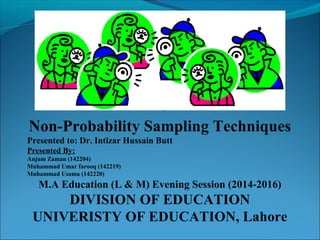
Non Probability Sampling
- 1. Non-Probability Sampling Techniques Presented to: Dr. Intizar Hussain Butt Presented By: Anjum Zaman (142204) Muhammad Umar farooq (142219) Muhammad Usama (142220) M.A Education (L & M) Evening Session (2014-2016) DIVISION OF EDUCATION UNIVERISTY OF EDUCATION, Lahore
- 2. Study Guide (Overview) a) What is Population ? b) What is Sample ? c) What is Probability sampling ? d) What is Non-probability sampling ? e) What is Convenient sample ? f) What is Quota sample ? g) What is Judgment sample ? h) What is Snowball sample ?
- 3. What is a Population? DEFINITION: The group to which you want to generalize your findings. IN OTHER WORDS: The larger group you are representing with your sample. OR The larger group to which your results will apply.
- 4. What is a Sample? DEFINITION A subset of the population being studied from which data is actually collected. A good sample accurately represents all kinds of elements/members in proportion to their presence in the population.
- 5. Sampling Techniques “Sampling techniques are the processes by which the subset of the population from which you will collect data are chosen”. There are TWO general types of sampling techniques: 1) PROBABILITY SAMPLING 2) NON-PROBABILITY SAMPLING
- 6. Non-Probability Sampling DEFINITION The process of selecting a sample from a population without using (statistical) probability theory. NOTE THAT IN NON-PROBABILITY SAMPLING Each element/member of the population DOES NOT have an equal chance of being included in the sample, and The researcher CANNOT estimate the error caused by not collecting data from all elements/members of the population.
- 7. Example Let's say that the university has roughly 10,000 students. These 10,000 students are our population (N). Each of the 10,000 students is known as a unit, but it’s hardly possible to get known and select every student randomly. So, here we can use Non-Random selection of sample to produce a result, it is called sampling.
- 8. Why we use this Technique ? (Advantages) In this technique the sampling process is much easier, quicker and cheaper . In this technique the sampling process is least time consuming. We use it, when randomization is impossible like when the population is almost limitless. Research does not aim to generate results that will be used to create generalization pertaining to the entire population.
- 9. Types of Non-Probability Sampling 1. Convenience Sampling 2. Quota Sampling 3. Purposive (Judgmental) Sampling 4. Snowball Sampling
- 10. Convenient Sampling DEFINITION; Selecting easily accessible participants with no randomization. For example; In our example of the 10,000 university students, if we were only interested in achieving a sample size of say 100 students. we may simply stand at one of the main entrances to campus, where it would be easy to invite the many students that pass by to take part in the research. So, it is very easy (Convenient) to select.
- 11. SELECTION OF PARTICIPANTS TYPE OF SAMPLING SELECTION STRATEGY PURPOSE Convenience Select cases based on their availability for the study. Saves time, money and effort; but at the expense of information and credibility.
- 12. Quota Sampling DEFINITION Selecting participant in numbers proportionate to their numbers in the larger population, no randomization. For example ; The number of students from each group that we would include in the sample would be based on the proportion of male and female students amongst the 10,000 university students. (Proportion; 50 male & 50 Female or 40 Female & 60 Male)
- 13. SELECTION OF PARTICIPANTS TYPE OF SAMPLING SELECTION STRATEGY PURPOSE Quota; Select a sample that yields the same proportions as the population proportions on easily identified variables. Taking a set number of cases from each subgroup to raise analytic confidence and representativeness .
- 14. Purposive (Judgmental) Sampling DEFINITION Purposive sampling, also known as judgmental, selective or subjective sampling, reflects a group of sampling techniques that rely on the judgment of the researcher; when it comes to selecting the units that are to be studied. For Example Specific People, Specific cases/organizations, Specific events, Specific pieces of data)
- 15. SELECTION OF PARTICIPANTS TYPE OF SAMPLING SELECTION STRATEGY PURPOSE Purposive All cases that meet some criteria. Useful for quality assurance.
- 16. Snowball Sampling DEFINITION Selecting participants by finding one or two participants and then asking them to refer you to others. For example; Meeting a homeless person, interviewing that person, and then asking him/her to introduce you to other homeless people you might interview.
- 17. SELECTION OF PARTICIPANTS TYPE OF SAMPLING SELECTION STRATEGY PURPOSE Snowball or chain referral Group members identify additional members to be included in the sample. Identifies cases of interest to people who know people, who know what cases are information-rich.
- 18. Drawbacks The results Reliability cannot be measured in non- probability sampling. There is no assurance that the estimates (Judgment) will meet an acceptable level of error. This results in selection are biased. Problem of non-representativeness.
- 19. THANK YOU All
